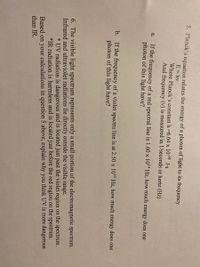
Chemistry
10th Edition
ISBN: 9781305957404
Author: Steven S. Zumdahl, Susan A. Zumdahl, Donald J. DeCoste
Publisher: Cengage Learning
expand_more
expand_more
format_list_bulleted
Question

Transcribed Image Text:5. Planck's equation relates the energy of a photon of light to its frequency.
E= hv
Where Planck's constant h =6.64 x 10-34 J.s
And frequency (v) is measured in 1/seconds or hertz (Hz)
If the frequency of a red spectral line is 1.60 x 1014 Hz, how much energy does one
photon of this light have?
a.
b. If the frequency of a violet spectra line is at 2.50 x 1014 Hz, how much energy does one
photon of this light have?
6. The visible light spectrum represents only a small portion of the electromagnetic spectrum.
Infrared and ultraviolet radiations lie directly outside the visible
range.
* UV radiation is dangerous and is located just past the violet region on the spectrum.
*IR radiation is harmless and is located just before the red region on the spectrum.
Based on your calculations in question 5 above, explain why you think UV is more dangerous
than IR.
Expert Solution
This question has been solved!
Explore an expertly crafted, step-by-step solution for a thorough understanding of key concepts.
This is a popular solution
Trending nowThis is a popular solution!
Step by stepSolved in 3 steps

Knowledge Booster
Learn more about
Need a deep-dive on the concept behind this application? Look no further. Learn more about this topic, chemistry and related others by exploring similar questions and additional content below.Similar questions
- Which of the following sources produces the highest energy photons? Show the calculation, or give a thorough explanation. a doctor's X-ray source b. the heat lamp in your bathroom e. a microwave oven d. gamma rays from a star radio waves from your local station а. с.arrow_forward2. Determine the energy (in Joules) of light with a frequency of 4.5 x 1010 Hertz. What region of the electromagnetic spectrum is this in?arrow_forwardCalculate the wavelength of yellow light in nanometers if the light has a frequency of 4.14 x 1014 s-1arrow_forward
- Wave, light, and energy emission in atoms:a. Given the speed of sound as 343.2 m/s, calculate the frequency of a sound wave of wavelength 15 m.b. The wavelength of emission from a sodium atom is 589.3 nm. What flame color would you expect for sodium? Explain.c. Mercury has an emission wavelength of 454 nm from the relaxation of an excited state to a lower energy state. Predict the color of this emission.arrow_forwardA mercury atom emits light at many wavelengths, two of which are at (1) 404.7 nm and (2) 435.8 nm . Both of these transitions are to the same final state. Determine the energy of each emitted wavelength (in J). a. E1 = 5.908 x 10-19 J and E2 = 5.558 x10-19 J b. E1 = 4.628 x 10-19 J and E2 = 4.968 x10-19 J c. E1 = 7.908 x 10-19 J and E2 = 6.558 x10-19 j d. E1 = 4.908 x 10-19 J and E2 = 4.558 x10-19 Jarrow_forwardAn electron in a hydrogen atom transitions from n = 3 to n = 5. Which of the following statements is true? A. There is not enough information B. a photon of wavelength 1.28 nm is emitted C. a photon of wavelength 1.28 nm is absorbed D. a photon of wavelength 1.28 um is emitted E. a photon of wavelength 1.28 um is absorbedarrow_forward
- 3.What is the amplitude of a wave? A.the distance between two crest points of a wave B.the number of times per second the wave cycles C.the energy and loudness of the wave D.the height of the wave from its rest position to its crest or trougharrow_forwardWhen element X undergoes a certain transition, the wavelength of the emitted radiation is 1037 nm. A student, however, measures the wavelength to be 1254 nm. What is the % error of her measurement? A. 17% B. 31% C. 37% D. 11% E. 21%arrow_forwardF. A certain light has a wavelength of 475 nm. How long (in s) does it take for this wave to complete one cycle? -15 A: 1.58 × 10arrow_forward
- Describe the process by which an atom absorbs a photon to move an electron in an atom. Your answer must include the following words or phrases: 1. absorb2. electron3. higher or lower (choose one)4. farther or closer (choose one)5. nucleus6. principal energy level, narrow_forwardI want to ask how to solve this problem. Thank you !arrow_forwardThis is from a study guide for a final, not a graded assignment.arrow_forward
arrow_back_ios
SEE MORE QUESTIONS
arrow_forward_ios
Recommended textbooks for you
 ChemistryChemistryISBN:9781305957404Author:Steven S. Zumdahl, Susan A. Zumdahl, Donald J. DeCostePublisher:Cengage Learning
ChemistryChemistryISBN:9781305957404Author:Steven S. Zumdahl, Susan A. Zumdahl, Donald J. DeCostePublisher:Cengage Learning ChemistryChemistryISBN:9781259911156Author:Raymond Chang Dr., Jason Overby ProfessorPublisher:McGraw-Hill Education
ChemistryChemistryISBN:9781259911156Author:Raymond Chang Dr., Jason Overby ProfessorPublisher:McGraw-Hill Education Principles of Instrumental AnalysisChemistryISBN:9781305577213Author:Douglas A. Skoog, F. James Holler, Stanley R. CrouchPublisher:Cengage Learning
Principles of Instrumental AnalysisChemistryISBN:9781305577213Author:Douglas A. Skoog, F. James Holler, Stanley R. CrouchPublisher:Cengage Learning Organic ChemistryChemistryISBN:9780078021558Author:Janice Gorzynski Smith Dr.Publisher:McGraw-Hill Education
Organic ChemistryChemistryISBN:9780078021558Author:Janice Gorzynski Smith Dr.Publisher:McGraw-Hill Education Chemistry: Principles and ReactionsChemistryISBN:9781305079373Author:William L. Masterton, Cecile N. HurleyPublisher:Cengage Learning
Chemistry: Principles and ReactionsChemistryISBN:9781305079373Author:William L. Masterton, Cecile N. HurleyPublisher:Cengage Learning Elementary Principles of Chemical Processes, Bind...ChemistryISBN:9781118431221Author:Richard M. Felder, Ronald W. Rousseau, Lisa G. BullardPublisher:WILEY
Elementary Principles of Chemical Processes, Bind...ChemistryISBN:9781118431221Author:Richard M. Felder, Ronald W. Rousseau, Lisa G. BullardPublisher:WILEY

Chemistry
Chemistry
ISBN:9781305957404
Author:Steven S. Zumdahl, Susan A. Zumdahl, Donald J. DeCoste
Publisher:Cengage Learning

Chemistry
Chemistry
ISBN:9781259911156
Author:Raymond Chang Dr., Jason Overby Professor
Publisher:McGraw-Hill Education

Principles of Instrumental Analysis
Chemistry
ISBN:9781305577213
Author:Douglas A. Skoog, F. James Holler, Stanley R. Crouch
Publisher:Cengage Learning

Organic Chemistry
Chemistry
ISBN:9780078021558
Author:Janice Gorzynski Smith Dr.
Publisher:McGraw-Hill Education

Chemistry: Principles and Reactions
Chemistry
ISBN:9781305079373
Author:William L. Masterton, Cecile N. Hurley
Publisher:Cengage Learning

Elementary Principles of Chemical Processes, Bind...
Chemistry
ISBN:9781118431221
Author:Richard M. Felder, Ronald W. Rousseau, Lisa G. Bullard
Publisher:WILEY